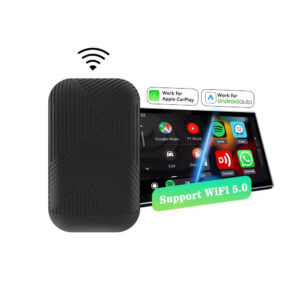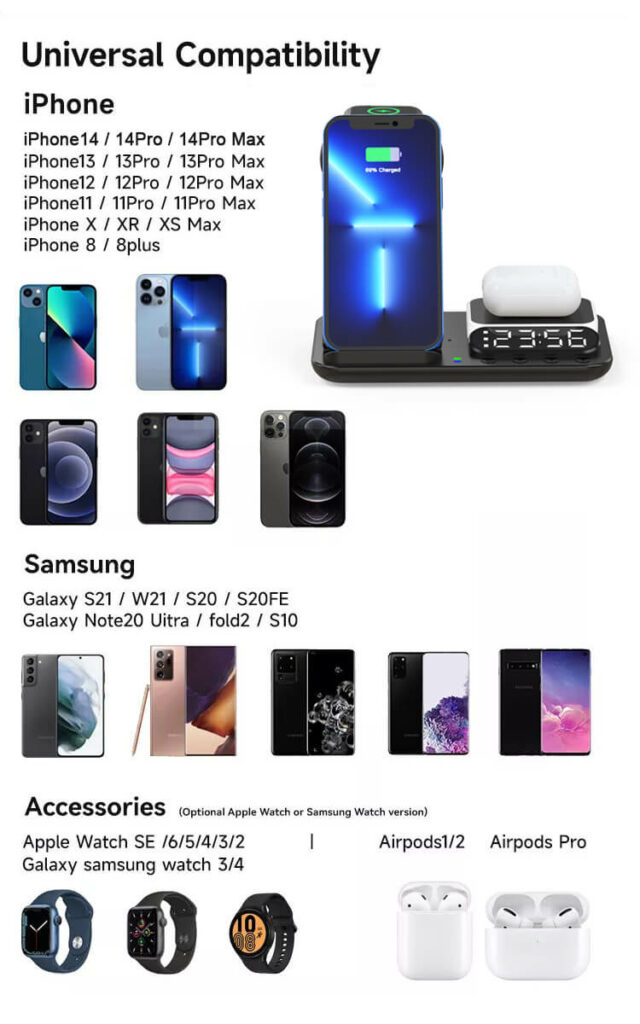Wireless Charging For Your Mobile Phone

What is Wireless Carplay adapter?
Regarding the Wireless CarPlay adapter, let’s first understand CarPlay. What is Carplay? In the center console of a car, there
When it comes to wireless charging, can you remember where it has appeared before?
At first, wireless charging was not that popular.
As nature’s environment changed and the concept of protecting the environment became stronger and stronger, in 2000, put into the market, fully automatic sensor
handwashers , sensor flushing toilets, saving water and living a cleaner and healthier life, became popular. Then electric toothbrush
Wireless charging, electric car wireless charging appeared in our sight.
The most common one is still wireless charging on mobile phones
Wireless charging has been increasingly integrated into various devices such as smartphones, smartwatches, and wireless earbuds. It has also appeared in some furniture designs, such as tables and lamps, which have the wireless charging function built into their surfaces. The technology has even been adapted for use in certain electric vehicles, allowing for a more convenient and efficient charging experience.
In this article, you will know:

Traditional charging methods can be a hassle, whether you’re searching for a power outlet in public or dealing with cords that always seem to get tangled. Wireless charging solves these problems by allowing you to charge your devices without a physical connection to the charger. The benefits of wireless charging include convenience, efficiency, and safety.
Wireless charging, also known as inductive charging, is a way to charge electronic devices without the need for a physical connection between the device and the charging station. Instead, it uses electromagnetic fields to transfer energy from the charger to the device being charged.
The process involves a charging pad or mat that contains a coil of wire which generates an alternating current. This current creates a magnetic field that induces a current in a second coil inside the device being charged, which then converts the energy into direct current to charge the device’s battery.
One of the most significant advantages of wireless charging is the convenience it offers. Instead of fumbling with cords and cables, users simply place their device on a charging pad and let it charge. This feature makes wireless charging ideal for public spaces like airports, cafes, and libraries, where people can charge their devices without worrying about carrying around cords or finding an available power outlet.
Wireless charging technology has also improved over the years, making it faster and more efficient. There are now 3-in-1 wireless chargers that can charge multiple devices at once, like an iPhone, Apple Watch, and AirPods. Additionally, there are car wireless iPhone chargers that can be used while driving, eliminating the need for cords and adapters.
Wireless charging is not limited to Apple devices, either. Many Android devices, such as Samsung Galaxy phones, also support wireless charging. Even older iPhone models, like the iPhone SE and iPhone 11, have been updated to support wireless charging.

Wireless charging uses electromagnetic fields to transfer energy from the charging pad or mat to the device being charged through a coil of wire generating an alternating current. This creates a magnetic field that induces a current in a second coil inside the device being charged, which then converts the energy into direct current to charge the device’s battery.
Simply put, plug in an adapter for a wireless charger, which must be compatible with the wireless charger. Then, turn on the power, and if there is no phone in the sensing area, the wireless charger will not work. Check if your device supports wireless charging function, and then align the device’s cable coil with the wireless charger to charge. There is also an LED on the wireless charger that shows whether it is sleeping or charging.
Wireless charging has become more ubiquitous in public spaces, making it easier than ever to stay connected on the go. With standards like Qi, you can charge your device quickly and even charge multiple devices at the same time with 3-in-1 wireless chargers or
From the previous 10W wireless charger, has now been upgraded to 15W, 20W. style applications are also becoming more and more abundant, from the basic wireless charging tablet, to wireless charging phone stand, to three-in-one multi-function wireless charging cable. The furniture desktop embedded wireless charger, single coil, to multi-coil fast charger, alarm clock lamp speaker wireless charger, to this day, in the vicinity of shopping malls, high-speed railway stations, airports are equipped with wireless chargers for cell phones, now the production of brand-name cell phones also have wireless charging capabilities, so charging no longer worry about your charging cable is Typc port, or Micro port, or light port.
Wireless charging is not just limited to Apple devices. Many Android devices, such as Samsung Galaxy phones, also support wireless charging. Even older iPhone models, like the iPhone SE and iPhone 8, have been updated to support wireless charging. Accessories and cases can also be compatible with wireless charging.

According to Brand Finance’s Global 500 2022 report, the top 10 global mobile phone brands are:
1. Apple
2. Samsung
3. Huawei
4. Xiaomi
5. Oppo
6. Vivo
7. Realme
8. Lenovo
9. LG
10. Nokia
As for the models that support wireless charging function, here are some examples:
· Apple iPhone 8, iPhone 8 Plus, iPhone X, iPhone XR, iPhone XS, iPhone XS Max, iPhone 11, iPhone 11 Pro, iPhone 11 Pro Max, iPhone 12, iPhone 12 mini, iPhone 12 Pro, iPhone 12 Pro Max, iPhone 13, iPhone 13 mini, iPhone 13 Pro, iPhone 13 Pro Max
· Samsung Galaxy S6, Galaxy S6 Edge, Galaxy S6 Edge+, Galaxy S7, Galaxy S7 Edge, Galaxy S8, Galaxy S8+, Galaxy S9, Galaxy S9+, Galaxy S10, Galaxy S10+, Galaxy S10e, Galaxy S20, Galaxy S20+, Galaxy S20 Ultra, Galaxy S21, Galaxy S21+, Galaxy S21 Ultra, Galaxy Note 5, Galaxy Note 8, Galaxy Note 9, Galaxy Note 10, Galaxy Note 10+, Galaxy Note 20, Galaxy Note 20 Ultra
· Huawei Mate 20 Pro, Mate 30 Pro, P30 Pro, P40 Pro
· Xiaomi Mi 9, Mi 9 Pro, Mi 9 Explorer, Mi 10, Mi 10 Pro, Mi 11, Mi 11 Pro
· LG G7 ThinQ, G8 ThinQ, V30, V35 ThinQ, V40 ThinQ, V50 ThinQ, V60 ThinQ, Velvet
· Nokia Lumia 930, Lumia 1520, Lumia 735, Lumia 830, Lumia 950, Lumia 950 XL
· Oppo Find X2 Pro, Reno4 Pro 5G, Reno5 Pro 5G, Reno6 Pro 5G
· Vivo X60 Pro, X60 Pro+, IQOO 7 Legend, IQOO 8 Pro
Please note that this list is not exhaustive and that there may be other models from these brands or other brands that support wireless charging. Additionally, some models may require additional accessories such as a wireless charging pad to enable the wireless charging function.
If used properly, wireless charging technology is usually considered safe. However, you should take some preventive measures to ensure the safety of the wireless charging process. Firstly, it is important to use wireless charging boards or racks certified by well-known organizations, such as Wireless Power Alliance (WPC) or Underwriters’ Laboratories (UL). This certification ensures that the charging board has undergone safety testing and meets certain standards. Generally speaking, the wireless chargers sold to you are tested layer by layer. There won’t be any problems. Secondly, it is important to ensure that your phone is properly placed on the charging board. Ensure that the charging coil on the phone is correctly aligned with the charging board to avoid overheating or other issues during phone charging. Finally, it is important to avoid using damaged or third-party charging accessories, which may pose safety hazards. Please always use the original charging cable and adapter included with your phone, or use certified accessories from well-known brands.
Wireless charging is already being used in wearable technology and smart homes, and it has the potential to be integrated into electric vehicles and drones in the future. Standardization of wireless charging technology will make it even more accessible and useful for users.
Wireless charging is the future of charging, offering convenience, efficiency, and safety to users. It’s time to upgrade your charging game and switch to wireless charging for all your charging needs. Whether you have an iPhone 13, iPhone SE, or iPhone 8, wireless charging is available to make your life easier and safer.

Regarding the Wireless CarPlay adapter, let’s first understand CarPlay. What is Carplay? In the center console of a car, there
1-1-300x152.jpg)
Dear partners and customers, We sincerely invite you to participate in the 2024 Spring Hong Kong Electronics Exhibition. As a

magnetic car holders in themselves do not disrupt wireless charging, unless the specific design places the magnet too close to
Phone: 0086-755-89812186
Email: sales@inputcn.com
Address: 518129 2F Building 1, Baoli Industrial Zone,
Bantian, Longgang District, Shenzhen, China.

